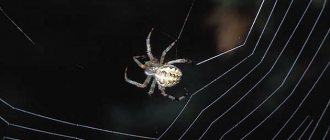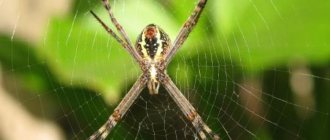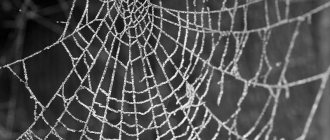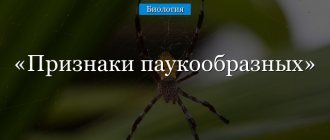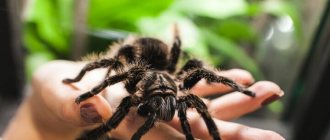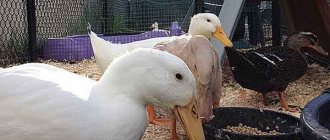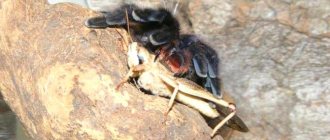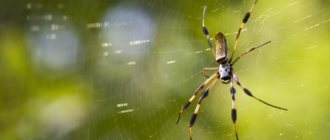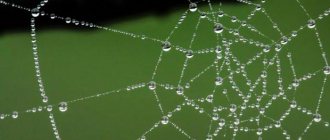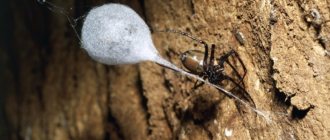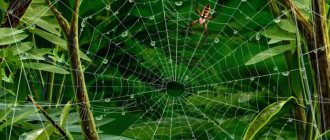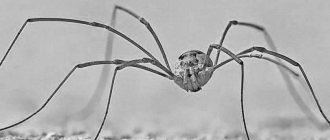Many animals know how to build homes and traps using available materials. For example, almost all birds make their own nests, and bees create huge hives. But some of the most complex structures are created by spiders, which secrete webs from their glands and weave traps for their victims. When prey is caught on sticky threads, each spider quickly rushes to it to sprinkle it with poison to turn all the insides into a nutrient mixture. Scientists have been monitoring these amazing creatures for many years and discover something new every time. For example, scientists from the US state of Maryland recently used night vision cameras and artificial intelligence to better understand the method of weaving spider webs. It turned out to be quite an interesting video.
Artificial intelligence has suggested how spiders weave their webs
What is a web?
The web is the secretion of the arachnoid glands, which are located at the back of every spider's body. Inside the gland, this substance is in a liquid state, but as soon as it is exposed to air, it instantly hardens in the form of threads. The main component of the spider thread is the protein fibroin , which in contact with air gives it strength. It is believed that one strand of spider web is several times stronger than a human hair of the same thickness. Spiders have several types of glands, each of which produces a different type of web. One variety is needed to create the base of a trap, another is used to weave a “catching” net, a third is used to bind the victim, and so on.
Spider releases web from arachnoid gland
A wonderful creation of nature - the web
Cobweb
A person doesn’t even imagine how fabulous this thing of nature is when, stumbling upon a cobweb in the park, he irritably brushes it off his face. If the length of an ordinary web were equal to the length of the equator, it would have a mass of only about 0.4 kg. It turns out that the simplest spider has the strongest and most elastic material found on planet Earth. By secreting an adhesive component to lubricate the web threads, the spider can weave them of varying lengths and thicknesses.
With the help of thin threads of web stretched in different directions from its shelter, the spider, which has naturally poor eyesight, is able to communicate with the environment. The web is his material for construction. Also, with its help, the spider extends its genus and habitat - the flying web takes its offspring with it far from the place of birth.
Interesting: Karakurt or black widow - description, habitat, nutrition, reproduction, enemies, photos and videos
How is a web weaved?
The basis of each spider trap is 3-4 load-bearing threads. This is the strongest part of the web. Radial threads are attached to the base, each end of which is attached to a support in the form of a tree branch, plant leaves, and so on. The spider applies a trapping spiral to the radial threads, which is the stickiest part of the trap. It is precisely this that spiders fall prey to—to prevent the prey from freeing itself, the predator quickly runs to it and injects poison. These substances transform the insides of insects caught in the web into a nutrient mass, which the spiders simply absorb into themselves.
The structure of the web
The web is a reliable refuge for offspring
The female lays eggs after fertilization in a cocoon woven from one or more silky threads. The cocoon itself is formed by 2 plates - the main and covering plates, connected by their edges. This cocoon structure provides reliable protection for the eggs.
The female first weaves a main plate, similar to the spermatic net for eggs. From above it wraps them with a second layer of web, which forms a covering plate. The shell of the cocoon is formed by silk threads tightly adjacent to each other and impregnated with frozen secretion. The walls of the cocoon become very dense, almost like parchment. In some species of spiders, the female weaves a loose cocoon that looks like a ball of cotton wool.
Spider offspring grow in the webs.
How do spiders walk on webs?
If a spider steps on a trapping net, it can easily become entangled in it. To avoid this, arthropods touch them only with the tips of their legs, which are covered with a large number of hairs - they reduce the area of contact with sticky substances. In addition to this, the limbs of spiders have a certain amount of oiliness, which prevents sticking. When the web is completely ready, predators try to walk only along radial threads.
Spiders don't get entangled in webs because they know how to walk on them correctly.
Trap nets
Trap nets
. Tenets are used for catching prey, although they are often at the same time the permanent residence of the animal. Stray spiders watch for prey or pursue it and capture it with one (Salticidae, Oxyopes) or several jumps (Lycosidae, Pisauridae, etc.). Dipoena tristis watches for ants, hanging on a spider's web thread above the soil in places where these insects are common (Fig. 121). Suddenly grabbing the ant, the spider lifts it to a plant branch, to which it is connected by a thread, and eats it there. But even in these cases, when there is no snare, the spider entwines the prey with more or less dense web threads, and large mygalomorphic spiders, having raised the prey high in the chelicerae, weave a small web mat, to which they then attach it (Avicularia, Eurypelma, Grammostola). Spiders that live in burrows and tubes usually recognize the approach of prey; when the prey touches the signal threads associated with the mouth of the lair (Liphistius, some Mygalomorphae, Filisiata - see Fig. 123, Segestria, Amaurobius, etc.), then they appear at the entrance and grab it.
Rice. 121. Dipoena tristis hunting ants (from Matveev)
Among the inhabitants of minks, the only remarkable exception is Cyrtocarenum cunicularum (Ctenizidae), which weaves a special trapping net. Leaving its burrow at night, this spider first attaches the lid with cobweb threads to surrounding objects so that it does not slam shut, then makes a snare nearby, 15 times long and 1.5 times high. Having caught a Pimelia beetle (Tenebrionidae) and sucked it out, the spider goes into a burrow. The network is rewoven every night. In the vast majority of cases, real web spiders passively wait for prey to fall into the web.
Quite often the nets are organically connected with housing; for example, the body tube in Tegenaria, Agelena and other Agelenidae, as well as in Dipluridae, continues into a funnel-shaped or flat trapping net. The spider jumps out of the tube when an insect gets caught in the net. Uroctea durandi captures prey in or near its lair, which consists of an irregular web of web filaments (Crome, 1957). In this case, the victim is pelted with long spider web fibers and, finally, entwined with them (Fig. 122, A and B). Dictyna viridissima places zigzag trapping cribellar threads on the surface of the substrate near its lair, and D. arundinacea extends them from the lair to neighboring plant branches. In Stegodyphus (Eresidae), Araneus alsine and Zilla (Araneidae), the tenet is connected to the lair by signal threads. Finally, most of the web spiders constantly live on webs and eat prey here (Linyphia, Theridiidae, Nephila, Argiope, etc.). The trapping net in these cases becomes the secondary shelter of the spider.
Rice. 122. Uroctea durandi, entwining the victim (according to Krome). A and B - the beginning and end of prey entanglement
The difficult question of the phylogenetic development of trap nets was developed by Bristow (1930, 1939, 1941), who showed that the evolution of snares followed two independent paths. For some spiders, trapping networks probably arose from burrow lairs, or rather from their cobweb lining. Primitive structures are those of Liphistius or Filistata, where the filaments diverge radially from the mouth of the tube (Fig. 123). These can be threads at the mouth, or threads that support the edge of the arachnoid lining of the shelter and are its continuation (Fig. 124, 3). They can also play the role of signal threads, warning of the approach of prey or an enemy. The next stage of development is represented, for example, by the structures of Amaurobius, Agelenidae, etc., where the mouth of the tube expands in the form of a funnel, which then gradually turns into a trapping net such as an awning or panel (Agelena, Tegenaria - Fig. 124, 5). Sitting in a web tube-shelter, the spider lies in wait for insects crawling onto the trapping net. It is typical for buildings of this kind that, firstly, the cocoon with eggs is always hidden in the depths of the shelter, and is not placed openly in the area of the trapping net, and, secondly, the spider runs along the upper side of the net.
Rice. 123. Spider web Filistata sp. (according to Comstock)
Rice. 124. Evolution of the arachnoid structure from a sac-like shelter (1) to a web tube (burrow) without a door (2) and with a door (6, 7, and through a funnel-shaped expansion of the mouth (3,4) to a tent-panel (5) (according to Bristow )
124. Evolution of the arachnoid structure from a sac-like shelter (1) to a web tube (burrow) without a door (2) and with a door (6, 7, and through a funnel-shaped expansion of the mouth (3,4) to a tent-panel (5) (according to Bristow )
Another line of phylogenetic development of tenets is characteristic of spiders that hunt for insects among plants. Initially they did not make shelters. They hung their cocoon from branches and leaves and guarded it by hanging next to it on a horizontal web thread. The threads supporting the cocoon warned of the approach of prey or an enemy (Fig. 125, 1). Gradually, by adding new threads around the cocoon, a simple random network was created, an example of which is the snare of Theridiidae. However, often such networks reach a certain level of perfection, since they are built according to a specific plan. Thus, the wide-loop network of Theridium or Teutana has vertically running adhesive threads that form a thick “picket fence” near the ground - a trap that is almost insurmountable for crawling insects (Fig. 126, A). The next stage of development is probably represented by the roof-shaped and dome-shaped networks of Linyphiidae, Pholcidae and Hypochilidae. The first ones make characteristic horizontal “awnings” from a thick web, from which supporting threads diverge up and down (Fig. 126, B). Once within the confines of such a trap, the insects stumble upon vertical supporting threads and fall onto the awning, where a spider watches for them. In Pholcus, the nets consist of a dense roof-shaped plexus with tensile attachment threads above and below it. Other Pholcidae and Hypochilus make a thick, rounded dome, suspended by threads and concavely downward; the spider sits under this dome (Fig. 127). From these networks it is essentially not very far from the horizontal wheel-shaped networks, which are distinguished by a surprisingly regular arrangement of radial and spiral threads. The nets of this line of development are characterized by the open location of the cocoon in the center of the network and the fact that the spider runs with its back down along the lower surface of the horizontal network (see Fig. 125, 3). If a shelter develops, then it is secondary.
Rice. 125. The evolution of arachnoid nets from threads suspending a cocoon (1) to an irregular network (2) and a regular wheel-shaped network (3), I also to a network in the form of an awning or tent without a lair (4) or with a lair (5) (according to Bristow )
Rice. 126.. Trapping networks of tenet spiders (according to Kästner). A - Teutana castanea; B - Linyphla sp
Rice. 127. Hypochllus thorelli dome net (according to Kästner and Gerhardt)
The most advanced type of nets, therefore, are wheel-shaped nets (Araneidae, Tetragnathidae and Uloboridae). A well-known example is the network of Araneus diadematus (Fig. 128). It consists of an outer support frame stretched with attachment threads between tree branches or other objects. The outer ends of the radii are attached to the frame, which in the middle of the network are connected to the central plexus. This latter is surrounded on the outside by the so-called attachment zone, followed by a space free of spiral threads. Even further outward there is a wide zone of a catching spiral, consisting of numerous turns of a single adhesive thread.
Rice. 128. Network of Araneus dladematus. Scheme (according to Vila)
Starting to build a trapping net, the spider releases a long thread, which is carried to the side by air currents and dangles freely until it catches on some object. Then the animal crawls along it, strengthening it with new web fibers. In this way, this first supporting thread (Fig. 129, 1-2) is easily pulled between very distant objects, for example, between tree branches spaced 2 or more inches apart.
Rice. 129. Network construction Araneas sp. (according to Berlan). Explanation in the text
Then the spider descends from a horizontal thread (from point 3) onto some object lying much lower. Here (4) he secures a second, usually oblique thread and rises along it to the first thread, all the time highlighting a new, third thread. He connects this last one for some distance (from 4 to 5) with the second one, but then leaves it free. Crawling further along the first horizontal thread for a certain distance (from 3 to 6), he attaches the free part of the third thread (at point 6). Thus, a triangular frame is obtained, with the apex facing down. Sometimes, however, a quadrangular frame is made or other options exist.
Then the threads are pulled, which lie in the plane of the frame and intersect the center of the future network, i.e. they are radii. Next, the remaining radii (about 30 in total) are extended from the center outward. With each new radius, the spider returns to the center and strengthens it. The radii do not unite at one central point, but are attached to a rather dense central plexus. Outward from it, with each return to the center, a transverse thread is stretched between the radii, so that an attachment zone is gradually formed.
Further, in the space that corresponds to the entire catching surface of the future net, starting at a certain distance from the attachment zone and gradually moving from the inside out, the animal lays a new spiral thread. This so-called auxiliary, or provisional, spiral (Fig. 129, G), consisting of several turns, is made of strong dry thread, and the spider sequentially moves from one radius to another. The auxiliary thread serves only to lay the definitive catcher spiral and plays the role of temporary support during this process. Having completed the auxiliary spiral, after a short pause the spider turns and lays out a new, much tighter spiral, now moving from the periphery to the center.
In those places where the radii run horizontally, the animal simply descends from the upper radius to the lower one (Fig. 130, A), but where they are vertical, it has to move the three sides of each cell with its front legs and guide the thread with the back pair of legs (Fig. 130, B). The definitive spiral thread is covered with droplets of sticky secretion and is a catching thread. As it lays the provisional thread, the spider bites off pieces, which it rolls into balls and then throws away, but part of the provisional thread is still retained around the center (see Fig. 128).
Rice. 130. Network construction of Araneas sp. A - laying adhesive thread between horizontal radii; B - the same between vertical radii (according to Berlan)
It is remarkable that the auxiliary spiral is made by all species that build wheel-shaped nets (Araneidae, Tetragnathidae, Uloboridae), as well as those that make the so-called fan-shaped nets, which are only a sector of the wheel-shaped network (Hyptiotes) (Fig. 136, A). In some forms, however, part of the auxiliary spiral is retained, and then among the turns of the adhesive catching spiral, a dry and smooth provisional spiral is distinguished (Nephila - Fig. 131). Cyriophora is generally limited to the provisional spiral, which here plays the role of trappers. Finally, in Uloborus the definitive spiral is made of a cribellar thread (Fig. 132), and in Sybota the catching apparatus is represented by cribellar threads of the frame and radii. Epeirotypus (Araneidae) has a very simplified wheel-shaped network; its vertical network has only three radii, and the few catching threads do not run in a spiral, but form two triangles. A signal thread stretches from the center of this simple network to the spider’s shelter (Fig. 133, A).
Rice. 131. Network site Nephila sp. 3-4 adhesive threads are visible between the provisional threads (from Vile)
Rice. 132. Network of Uloborus sp. (according to Ellis)
The central part of the network is either braided, as in Araneus (closed center - Cyclosa, Nephila, etc.), or a significant hole is left here (open center - Meta, Tetragnatka). In the latter case, the central plexus is first made, but then the spider bites off its threads, rolls them up and throws them away. In a number of Araneidae, the edges of the open center are associated with a cap-shaped lair.
Sometimes wheel-shaped nets are also equipped with so-called stabiliments (stabilimenta), i.e., more or less wide straight or zigzag, sometimes fluffy ribbons of thicker web yarn that diverge radially (Argiope - Fig. 133, B, Uloborus - Fig. 132) or arranged in a circle. Stabiliments are found in the nets of those species that spend their entire lives in the center of the web and probably serve as supporting devices for the heavy body of the spider. However, opinions regarding the role of these entities are different and contradictory. Sometimes cocoons (Cyclosa) are suspended from the stabilizers.
Rice. 133. Spider nets. A - Epeirotypus glorlae; B - Argiope pulchella (A - according to Petrunkevich, B - according to Hingston)
Wheel-shaped networks, which are very diverse in design details, are most often located vertically (Araneus, Argiope, Meta, Nephila), but can also be horizontal (Uloboris, Mela).
Of the various modifications of the wheel-shaped net, we note its simplification, which is often associated with the transition to an active method of catching prey and is known in Araneidae, Uloboridae and Dinopidae.
Among Araneidae, Theridiosoma weaves a vertical circular network, but, having bitten several radii around the center, connects them to each other into one thread, due to which the network becomes loose. A long signal thread stretches perpendicular to the plane of the network from the middle of it to the nearest plant. The spider is placed in the center of the web and pulls the signal thread with its front legs so tightly that loose thread loops are formed under its abdomen, and the entire web is stretched into a cone-shaped bag (Fig. 134). As soon as the insect touches the web, the spider suddenly releases the signaling thread. The previously stretched net, due to the elasticity of the threads, returns to its previous position, and the insect is tightly engulfed in adhesive threads.
Rice. 134. Theridiosoma gemmosum network (according to Millo)
Another interesting example is Cladomelea. The entire “net” is represented by only a few threads on which the spider hangs. When starting to catch prey, it releases a web thread up to 2 cm long with a drop of sticky secretion at the end. Then, with the help of the third pair of legs, the spider begins to quickly swing this thread, spinning it around itself, which continues for about 1/4 hour. If a droplet at the end of the thread touches an insect, it sticks to the thread, and then the spider pulls it towards itself and sucks it out. Then the spider prepares a new thread and begins to circle it again, and this fishing continues for hours. This method of obtaining prey is, of course, only possible in places where insects gather.
The closest relative of Cladomelea, Mastophora cornigera, also hunts with the help of an adhesive thread, but holds it in the outstretched front leg. Approaching the insect cautiously, the spider suddenly throws its “lasso” at it and pulls the stuck prey towards itself (Fig. 135).
Rice. 135. Mastophora cornigera, catching prey (according to Gersh)
It is remarkable that in a completely different group of web spiders, the Cribellatae, independently develop their own methods of active fishing, sometimes surprisingly similar to those of the Araneidae.
Thus, in Hyptiotes (Uloboridae), the triangular network is like a four-ray sector of the circular network Uloborus. A long signal thread stretches from the top of the net to the nearest branch or tree trunk, at the end of which there is a spider (Fig. 136, A). The animal faces the web with its front end and is suspended from a branch by means of a short thread emerging from the arachnoid warts (the so-called “precautionary thread”, often secreted by other spiders). Interestingly, the signal thread is not attached anywhere; the spider holds its free end with two front pairs of legs. As soon as the insect encounters the net, the spider suddenly lengthens the back thread, hanging freely, and the previously stretched net relaxes; Then quickly picking up the “safety thread” with its back pair of legs, the spider tightens the web again and immediately lets it loosen a second time. Thus, he ensures that the prey is completely entangled in the net. Approaching further to the prey, the spider extends the “precautionary thread”, and picks up the signal thread with its front legs, rolls it into a ball, which it throws out after reaching the net. Therefore, after each capture of prey, a new signal thread is made (Wiehle, 1931).
Rice. 136. Gribellatae trapping nets. A - Hyptiotes sp.; B - Miagrammopes sp. (according to Ackerman)
Another representative of the same family is Miagrammopes from South. In the mornings, Africa stretches one single horizontal thread from 0.9 to 3.6 m long between the branches of bushes and trees (Fig. 136, B). Then, moving along the thread with the help of the first and third pairs of legs, it covers its middle part with cribellar threads. This simple trap is an extremely simplified net, and yet large flies are often caught in it. The spider sits on one end of the thread in exactly the same way as Hyptiotes. When an insect touches a thread, the spider instantly weakens it, which helps entangle the prey (Akerman, 1932).
But perhaps the most remarkable example of active fishing using a modified wheel-shaped net is provided by Menneus camelus, a 12 mm long South African spider from Dinopidae. Its peculiar network is made between the branches of trees at nightfall. In the middle of the web, the spider arranges a small (about 2 cm) quadrangular vertical frame. Then, starting from the bottom edge, a series of parallel cribellar threads are pulled across the frame (Fig. 137). With the onset of night, in anticipation of prey, the spider takes a very characteristic pose: hanging by means of a “precautionary thread” from a horizontal support thread and clinging to the net with two pairs of hind legs, it firmly holds the corners of the quadrangle with the tips of its four front legs (Fig. 137, A). As soon as an insect (usually a moth) approaches the net, the spider instantly stretches the elastic quadrangle by the corners (Fig. 137, B) so that it increases in size by 5-6 times and envelops the prey with it. During the day, the spider sits somewhere on a branch, clinging to it, and is almost indistinguishable. A new net is made every night (Akerman, 1926).
Rice. 137. Network Menneus camelus, (no to Ackerman). A and B - different moments of catching an insect
